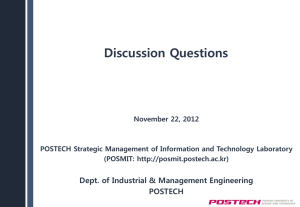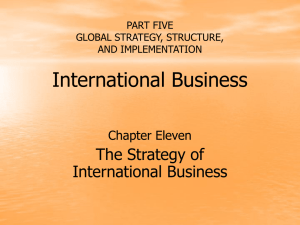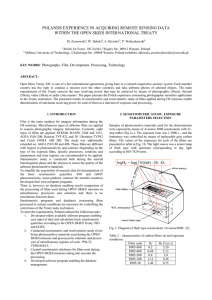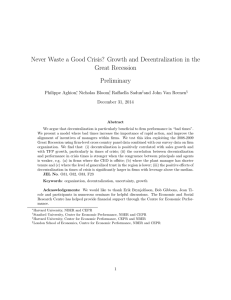Lecture06 - Duke University's Fuqua School of Business
advertisement
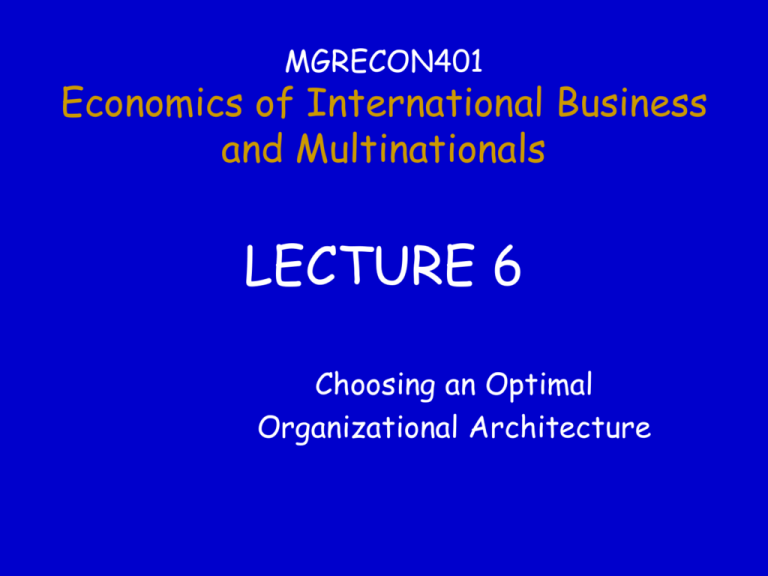
MGRECON401 Economics of International Business and Multinationals LECTURE 6 Choosing an Optimal Organizational Architecture 12-2 Lecture Focus Define the role of Organizational Architecture Centralization v. Decentralization Organizational Form: Functional, Multidivisional, Matrix Role of Globalization in Optimal Organizational Architecture 12-3 Determinants of Architecture 12-4 Organizational architecture Organizational structure: Location of decisionmaking responsibilities within the structure (vertical differentiation) Formal division of the organization into subunits e.g. product divisions (horizontal differentiation) Establishment of integrating mechanisms including cross-functional teams and or pan-regional committees Control systems : metrics used to measure performance of subunits and judge managerial performance 12-5 Organizational architecture Incentives: Devices used to reward appropriate employee behavior Closely tied to performance metrics Processes: Manner in which decisions are made and work is performed 12-6 Centralization versus decentralization benefits of decentralization Effective use of local knowledge local tastes and preferences price sensitivities of particular customers Conservation of management time senior management focus on strategy Training and motivation for local managers 12-7 Centralization versus decentralization costs of decentralization Potential agency problems effective control systems may be expensive Coordination costs and failures Less effective use of central information 12-8 Early Expansion of Industry Railroad companies emerged around 1850 Organized around basic functions: finance, pricing, traffic, and maintenance Steel, tobacco, oil, meatpacking followed a similar model As these companies expanded geographically, they fared poorly in product markets where they faced smaller, more focused competitors 12-9 Early Expansion of Industry Chandler: … in the centralized, functionally departmentalized operating company … the operations of the enterprise became too complex and the problems of coordination, appraisal, and policy formulation too intricate for a small number of top officers to handle both long-run, entrepreneurial, and short-run, operational administrative activities. 12-10 Early Expansion of Industry Companies like DuPont, General Motors, and General Electric experimented with different organizational forms Eventually adoped the M form (multidivisional) 12-11 AT&T 1980s AT&T slow moving regulated environment Adopted huge formal bureaucracy Important decision made from top down 1990s new AT&T Deregulation, increased competition, technological change Adopted large number of profit centers Run autonomously Pay-for-performance plans tied to units 12-12 Eastman Kodak Prior to 1980s monopoly in film production Centralized, top down bureaucracy 1980s Increased competition from Fuji and generics Technological explosion: communications, design, robotics Kodak lost market share and stock market value 12-13 Eastman Kodak 1984 restructuring 17 new business units with profit and loss responsibility Managers given increased authority for new products and pricing Bonus payment system 12-14 Unilever One of world’s oldest multinational corporations Organized on a decentralized basis Annual conferences on company strategy and executive education sessions, establish connections between managers Duplication of facilities and high cost structure a problem in new competitive environment 1996: introduced structure based on regional business groups “Lever Europe” established to consolidate the company’s detergent operation in order to reduce costs and speed up new product information 12-15 Changing Demand for Organizational Structure Jack Welch: We had constructed, over the years, a management apparatus that was right for its time … Divisions, strategic business units, groups, sectors, all were designed to make meticulous calculated decisions and move them forward and upward. The system produced highly polished work. It was right for the 70’s, a growing handicap for the 80’s, and it would have been a ticket to the boneyard for the 90s. 12-16 The functional structure Typically, the structure that evolves in a company’s early stages. Coordination and control rests with top management. 12-17 A typical functional structure Fig 13.3 12-18 Product division structure Probable next stage of development. Reflects company growth into new products. Eases coordination and control problems. Each unit responsible for a product. Semiautonomous and accountable for its performance. 12-19 A typical product divisional structure Fig 13.4 12-20 International division Widely used. 1. Can create conflict between domestic and foreign operations. 2. Implied lack of coordination between domestic and foreign operations. Growth can lead to worldwide structure. 12-21 Structure of the international division International division Organized on geography Initially export goods to foreign subsidiary but later engage in FDI or outsource production Problems Lack of coordination between domestic and foreign operations 12-22 One Company’s international division structure Fig 13.5 12-23 The International structural stages model Fig 13.6 12-24 Worldwide area structure Favored by firms with low degree of diversification. Area is usually a country. Largely autonomous. Facilitates local responsiveness. 12-25 Worldwide area structure Worldwide area structure Favored by firms with low degree of diversification & domestic structure based on function World is divided into autonomous geographic areas Operational authority decentralized Facilitates local responsiveness Fragmentation of organization can occur 12-26 A worldwide area structure Fig 13.7 12-27 Management focus-Abbot Laboratories One of world’s largest health care companies Originally consisted of three divisions Pharmaceuticals, hospital products & nutritional products Added international division on geographic lines to handle growing foreign sales Later added global product division to handle diagnostic businesses Abbot aims to build global products that can be launched simultaneously around the world Which structure should be adopted? Geographic division or global product division? 12-28 Product division Reasonably diversified firms. Attempts to overcome international division and worldwide area structure problems. Weak local responsiveness. Believe that product value creation activities should be coordinated worldwide. 12-29 World wide product divisional structure Adopted by firms that are reasonably diversified Original domestic firm structure based on product division Value creation activities of each product division coordinated by that division worldwide Help realize location and experience curve economies Facilitate transfer of core competencies Problem: area managers have limited control, subservient to product division managers, leading to lack of local responsiveness 12-30 A worldwide product division structure Fig 13.8 12-31 Matrix structure Attempts to meet needs of transnational strategy. Doesn’t work as well as theory predicts. Conflict and power struggles. “Flexible” matrix structures. 12-32 Horizontal differentiation: Global matrix structure Helps to cope with conflicting demands of earlier strategies Two dimensions: product division and geographic area Product division and geographic areas given equal responsibility for operating decisions Problems Bureaucratic structure slows decision making Conflict between areas and product divisions Difficult to make one party accountable due to dual responsibility 12-33 A Global matrix structure Fig 13.9 12-34 The Transformation of BP How do you evaluate BP’s “Atomic Organization?” What are its strengths and weaknesses? What are the positives and the negatives of the performance contracting system? If you were a BP leader in BP, what influence would such a system have on your behaviors? BP claims to have significantly benefited from the peer process: what are the requirements for such processes to be effective? What advice will you give to another company that is considering implementations of peer assist and peer challenges? 12-35 The Transformation of BP Do you agree with the company’s commitment to being a “force for good?” Is this commitment consistent with the role of a public company in a market economy? What role does top management play in BP? How is this role different from the role played by top management in companies you know, or have some experience with? 12-36 General Lessons from BP Focus activities of a firm to a select set Create business units with a clear scope of responsibility and clear accountability Give strong incentives for unit performance Link units horizontally rather than requiring all communication to pass up and down through the hierarchy 12-37 General Lessons from BP Flatten the hierarchy and increase the span of control Outsource Improve information, measurement, and communication systems Create a culture that is oriented to delivering performance


